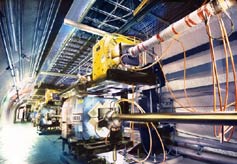
Handy Links
SLAC News Center
SLAC Today
- Subscribe
- Archives: Feb 2006-May 20, 2011
- Archives: May 23, 2011 and later
- Submit Feedback or Story Ideas
- About SLAC Today
SLAC News
Lab News
- Interactions
- Lightsources.org
- ILC NewsLine
- Int'l Science Grid This Week
- Fermilab Today
- Berkeley Lab News
- @brookhaven TODAY
- DOE Pulse
- CERN Courier
- DESY inForm
- US / LHC
SLAC Links
- Emergency
- Safety
- Policy Repository
- Site Entry Form

- Site Maps
- M & O Review
- Computing Status & Calendar
- SLAC Colloquium
- SLACspeak
- SLACspace
- SLAC Logo
- Café Menu
- Flea Market
- Web E-mail
- Marguerite Shuttle
- Discount Commuter Passes
-
Award Reporting Form
- SPIRES
- SciDoc
- Activity Groups
- Library
Stanford
Around the Bay
Strong Currents Ahead
 Midway through the four-month shutdown, the PEP-II rings are being primed for strong currents and big luminosity. By the end of the 2007 run, the rings will deliver 70 percent more luminosity to the BaBar experiment than during the record-breaking previous run.
Midway through the four-month shutdown, the PEP-II rings are being primed for strong currents and big luminosity. By the end of the 2007 run, the rings will deliver 70 percent more luminosity to the BaBar experiment than during the record-breaking previous run.
To achieve these goals, crews are working to create high luminosity—as many collisions between electrons and positrons as possible. In the aftermath, fascinating and surprising physics emerges. The upgrade plan is taking two routes to ultimately increase luminosity 70 percent: adding more particles to a bunch and compressing particles closer together within a bunch.
In the first of three projects, the vacuum systems around the interaction region (where the electron and positron beams collide) are being improved to handle stronger beam currents. More current literally means more electrons (or positrons) in the beam. But when those multitudes of charged particles circle the PEP rings, they emit synchrotron radiation that can damage the vacuum system. Therefore, accelerator engineers are working on better controlling the radiation power hitting the vacuum systems.
In another project to increase current, crews are installing two new RF (radio-frequency) stations to pump more RF power into the High Energy Ring. The aim is to boost current from 1.9 amperes to 2.2 amperes. The Low Energy Ring has operated at 3 amperes, but will run at its full capability of four amperes starting in January because the upgraded vacuum systems will be able to tolerate the higher current.
The third major project is a "higher tune" in the High Energy Ring to shorten the bunches. By intensifying the power to 200 focusing magnets in the ring, machine physicists will force individual particles to oscillate more often and hence stay closer together. Miles of new cable and stronger power supplies will provide higher magnetic fields in the magnets.
"All the crews in the different groups at SLAC working on the upgrades are doing a great job. We're looking forward to a very nice run coming up," said John Seeman, head of the Accelerator Systems Division.
—Heather Rock Woods
SLAC Today, November 2, 2006